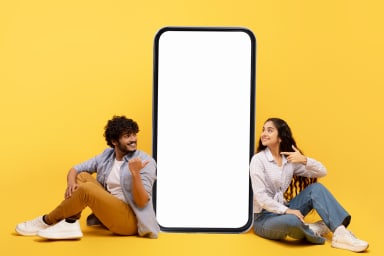Leonid Feigin is a creative director and co-founder of Direct Design Visual Branding (DDVB), a marketing agency, which has won more than a hundred awards in the field of advertising and graphic design. Among DDVB clients are major Russian and Western brands, including Coca-Cola, Nestle, Wimm-Bill-Dann, Alfa-Capital, Beeline, Samsung, and many others. We asked Leonid about the nuances of branding, including how to build an emotional connection with the audience and why a business should not deceive itself and its clients.
What is the difference between good and bad branding?
Good branding attracts the attention of those people for whom the product or service it designates will be interesting or useful. A good brand carries an emotional message that sets it apart from others, allowing people to remember the brand and build a personal relationship with it. Such a brand brings together those who use a product or service and those who create them, transforming them from producers and consumers to a community of people with a common idea.
A bad brand does the same thing, but vice versa: it attracts those who don’t need the product or service or might dislike it; it promises the quality or feature of the product or service that the manufacturer can’t provide; every time it meets a consumer it says different things, so it doesn’t create a whole image and is nameless.
Very often seemingly well-performed design or creatives are bad branding because they attract the wrong people or promise something that the business is unable or unwilling to do.
Should the approach to branding be different for micro and large businesses?
The only difference is that microbusiness has less right to make a mistake, so it is especially important for it not to lie – to itself and everyone around. Quality communication is based on truth. For example, “We put expired flour into scones because it’s good and scones are half as cheap. We like to make cheap products, and we talk honestly about our values.” But if you deceive people that you use luxury flour, the result is bad.
Why shouldn’t you lie to yourself first of all? Business is not about one person: you choose the environment, working team, contractors, the landlord. If a brand communicates very clearly about what it wants, what it believes in, and what it likes to do, it is likely to attract exactly the people who need it.
To not lie to yourself, you need to understand yourself. And if big companies have more decision-makers, then a microbusiness has direct access to the CEO, that’s you. Come to the mirror and ask yourself what you want, what you are capable of, what you will really do, what you are passionate about.
Without these questions, it is very difficult to set the task of promoting the brand, its “clothing”, appearance, and the efforts you’ll spend your energy and money on. A small business can’t do everything well at once: luxury packaging, excellent interior, and the best professionals, and a call center. While choosing what to invest in first rely on what you believe in and what is important for you.
What tools do you consider the most effective within a limited budget to convey emotion to the audience: content, visuals, or something else?
There’s no universal answer here. There are not so many solutions in the microbusiness: you can quickly try them and analyze their effectiveness, and if you don’t like them, just stop using them.
If you have micro-retail in a passageway street, nothing can be better than a good sign and a nice entrance area. If you have a call-out service, you need performance marketing and working with staff. If you have an online store, your brand will be manifested primarily in the tone of voice, in the tone of the message, in the correct selection of goods, in the aesthetics of the site.
But there are also different online stores. For some, it is better to communicate in communities, to promote through ambassadors and recommendations. For others, open banner advertising or performance marketing will work. It all depends on the product itself, the style of the store, your audience, and what you enjoy doing. If you are a super mommy and have opened a micro-market for moms and you have plenty of things to discuss with them – go to communities. Make communication your strong point: give information, advice, complain – and you will successfully sell to those who enjoy talking.
How important are visual branding elements such as logos, colors, and fonts in communicating emotions?
Everything is important because it addresses the emotional sphere, when we perceive subconsciously, without analyzing. When we meet a crowd of 25 people, you can just determine “your” people by the way they walk, dress, or look. How long do you think it will take you to look at each person?
Less than a second.
That’s right. People who scroll through the Tinder dating app, decide on whether to write to a person or not, in less than a second. You do not have time to read anything or to analyze rationally during this time. And your limbic system has time to make its conclusion, not always correct, but fast.
This emotional sphere refers to the territory of sounds, smells, colors, shapes, subjects, images – everything that is analyzed not by the brain, but by feelings. Based on these findings, you turn to the store (“Interesting”), hold your gaze (“I’ll think about it”), or speed up your step (“I’ll never go here”). Do you want people to pause on and give you credibility? We need to turn to this sphere, that is, the aesthetics of everything – from fonts to movement. There is nothing that can be excluded.
How to manage this process while creating branding?
Talk to capable people and understand exactly what you want. Not meaning “I want it red and square-shaped”, but “I want it to express warmth and trust.” A talented and qualified person should do it at a good level of aesthetics because people appreciate the quality of design.
I very often decide on whether or not I go to a place by its design – and I rarely make a mistake. A person who has ordered and realized good design is very likely to have the same requirements for the quality of his product or service.
Should the brand please the target audience, for example, create primitive advertising, if users like it?
In some questions, advertisers have to use simpler, coarse, bright forms that attract people and give them an answer to a very simple question: where is it really cheaper? It is necessary to talk to them using their language. This may be a rough matter, but it is clear and honest. The main thing is appropriateness. After all, the same person may require a completely different intonation – sincere, deep, and wise – when it comes to the child’s health, home decoration for a wedding, or a relationship with elderly parents.
Until we learn to treat each other as people, stupid, inappropriate, and ineffective advertising will be created. As soon as we understand that you are a human being, I am a human being, you do something, I buy it, then the question of pleasing will disappear. It is a question of cooperation. If the marketing techniques you use are interesting to me, I will be happy to follow them and will not be offended by you.
For example, as a consumer I don’t want to look at the contemporary art of Dutch artists: I want something clear, simple, tasty, and preferably shiny. You say: I love the contemporary art of the artists of the Netherlands. What do you want? To do me good or to show that you are smarter? If you choose the second option, then start an educational project, and if the first, you can enjoy contemporary art in the Netherlands as much as you want, but be kind enough to build a shiny thing for me with great respect.
Don’t people feel that they are being lied to?
If that disgusts you, then they will. So, once again, lying to yourself is no good. It is possible to be different. Have you ever communicated with children under seven years old? Have you ever noticed that they have slightly different logic and pace of perception of speech? When you change your pace of conversation and vocabulary for them to understand, you do not feel as if you betray your intellect. Were you insincere? On the contrary.
If you love this person and do something for them sincerely, without mocking, despising, but rather understanding the reasons, then you will succeed. If not, they’ll reveal you’re lying. It’s like when some insincere adults use baby talk but kids do not believe them anyway. If you do not find the strength to love the one for whom you work in the genre that you can afford, then change the genre until it becomes close to you. Especially if you are a microbusiness.
How has brand communication changed due to the pandemic and the global crisis?
Advertising has become even more interesting, accurate, and timely, delivery – fast, and the tone of the conversation – more individual, so that people can find their own tone to understand they feel good with it. Because the last thing left to us is a different style of conversation of Internet services. We will talk where it is more pleasant for us to talk. The personality of the brand has become essential even for a one-man super micro-service, because it conveys their character, communication and business style, which will be the reason to work with these very people.
Do all brands need storytelling?
Any brand may need it, but not always. A person may not have time and desire to go into history, listen to or read something. If the brand is trusted and has an opportunity to tell something, that’s great. If the wine costs 1200 rubles and there is a small history of the vineyard, it will be read. If the wine costs 350 rubles, no matter what you write there, a person considers it a lie in advance.
So, initially, a person goes by the price?
There are many factors, but the price is one of the most important. If you see a dirty man wearing rags, you will hardly believe that he is a bank director. You will conclude in advance that he is a beggar, based on his appearance. The price is the same. If the wine costs 1200 rubles, you approach the choice with the words “What they give me for this money”. And for 350 rubles you understand it is just wine.
And if the label and the bottle are beautiful, but it costs 350 rubles?
Wonderful. People will take it because it will be an emotional choice. But you have neither credibility nor time for stories. Storytelling is a wonderful eternal tool, but it requires time and attention. We are not ready to give our ears to anyone who wants to blow in them for any reason.
Let’s sum up what micro and small businesses should start branding development with.
With an honest analysis: what I want, what I can do, whether it is necessary for those people I do it for, and what way we are alike. What I respect and love them for, how can I be useful for them – that’s what the brand is about. All this has to be described briefly – half a page at most.
I recommend one useful exercise. Try to tell an 80-year-old, or better yet a 90-year-old person why you do your business. And then catch a five-year-old child and explain exactly what you do. Your consumer doesn’t care for what you do. He will pay you no more attention than a five-year-old child, so you should be ready to simplify your whole life and profession to very basic things. But the consumer thinks his life is utterly important, and he wants to talk about important things very seriously, as an 80-year-old man will do.
If you can do this exercise, you will most likely be able to write a half-page story about your business. Then ask other people to read and express their opinion. Think about how you can best express this description in everything you do: the logo, the design, the tone of the advertisements, the messages, the color of the walls, the assortment.
How can one understand it’s time for rebranding?
When this piece of paper does not say what you believe in. Or when you deeply believe in this text, but what you have actually done no longer reflects it: when fashion, meaning, or understanding has changed. In this case, you have to do restyling and introduce external changes.
For example, you wanted to say, “It’s cozy here.” You made a teddy-like design, provided checkered things with tassels and gold lamp shades. But time passed and it’s no longer cozy, but ridiculous. You understand that you still want to be cozy, but the concept of coziness has changed. Simple forms of Danish design, gray linen and graffiti on the walls are in fashion. If you believe in it, you need to change the interior, and if not, change the text on the leaf. Write that you like the old interior and you will work with those who like it too. If the leaflet says one thing, and people coming to you perceive another, then you do not have a brand.








